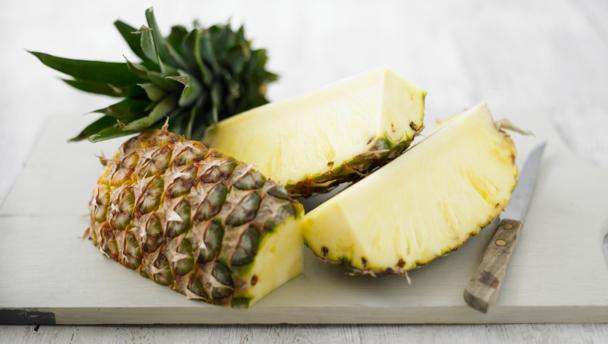

Pineapple is a spiky-skinned, tropical, compound fruit with aromatic, sweet-sour juicy yellow flesh and a fibrous core. Miniature varieties have a tender, edible core.
 Gammon and chips with pineapple and greens
Gammon and chips with pineapple and greens
 Pork sausages with pineapple salsa and rocket salad
Pork sausages with pineapple salsa and rocket salad
 Chargrilled sea bass summer rolls with pineapple dipping sauce
Chargrilled sea bass summer rolls with pineapple dipping sauce
 Christmas trifle
Christmas trifle
 Fruit tarts
Fruit tarts
 Tennis cake
Tennis cake
 Calypso swizzle
Calypso swizzle
 Buena Vida
Buena Vida
 Pisco punch
Pisco punch
Pineapples cannot ripen further once picked. To test for ripeness, pull out a leaf and sniff. If it comes away from the fruit easily, the pineapple is ripe: if the leaf smells of fermentation, it’s past its best.
Refrigerate cut pineapple, but cover tightly as it has a pervasive odour.
Super Sweet varieties of pineapple are mainly sold in the UK. These rarely need extra sugar to balance their acidity. Other varieties, such as Smooth Cayenne, will need sweetening. One medium pineapple serves four people.
To minimise waste, cut off the skin, then cut v-shaped diagonal ‘trenches’ from all around the pineapple to remove its ‘eyes’.
Pineapple flesh is eaten raw in salsas, desserts and sweet or savoury salads. Pineapple juice or purée is also good in exotic fruit drinks such as smoothies, especially those made with coconut water. It is also excellent cooked, especially griddled, fried or baked in cakes. Rum, cherry or orange liqueurs taste good with pineapple, as do citrus fruit and spices, including fresh chilli.
Raw pineapple juice will prevent gelatine from setting as it contains bromelain, an enzyme that breaks down protein. If you want to make pineapple jelly, you must cook the pineapple first.
Article by Sybil Kapoor
Type the ingredients you want to use, then click Go. For better results you can use quotation marks around phrases (e.g. "chicken breast"). Alternatively you can search by chef, programme, cuisine, diet, or dish (e.g. Lasagne).